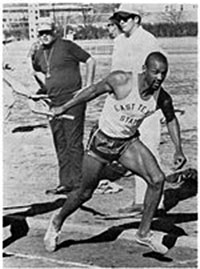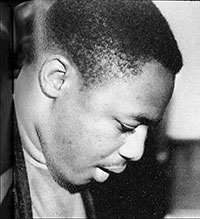Local Literacy Scene
When John Carlos and Joe Tave arrived at East Texas State University (ETSU) in 1966, the community had just begun the process of desegregation. Jim Crow’s impact remained strikingly present in everyday life across this sparsely populated area located approximately one hour east of Dallas, just as it did most everywhere across the American South at that time. Carlos was a sprinter from Harlem best known for his participation in the Silent Protest in Mexico City in 1968. Tave was a political science major raised in one of the area’s segregated communities. Just as he had in his hometown of nearby Mineola, Tave quickly took on leadership roles at ETSU, especially where such positions brought him together with others equally committed to racial justice.
Unlike Tave, however, Carlos had no first-hand experiences with segregation to prepare him for the injustices he and his young family would face. This sprinter from Harlem perhaps best known for his part in the Silent Protest at the Mexico City Olympics in 1968 was deeply informed by Malcolm X, who spoke regularly at the mosque in his neighborhood and from whom Carlos often sought advice. At ETSU, he turned the attention his athletic prowess attracted from the local press into a forum through which to challenge ongoing inequities. Though he would ultimately find it necessary to leave ETSU after only a year, he credits the racial tensions that forced him from this area with inspiring his involvement the next year with one of the most memorable social justice efforts in sports history, essentially taking ETSU’s ongoing struggles with him as he stood atop the medal stand in Mexico City.
Tave was, of course, no less inspired by civil rights leaders like Malcolm X, whose presence was felt in every American town with a television, radio, telephone, newspaper stand, or postal delivery. Martin Luther King, Jr.’s influence on Tave is far more obvious, however. Decades later, Carlos would say of his friend, with great admiration, “I always called Joe Tave the ‘MLK of East Texas.” He called himself the “Malcolm X of East Texas.” On the night of MLK’s assassination, in fact, Joe Tave established the Afro-American Students Society of East Texas (ASSET), an activist group that helped usher in unprecedented change across the campus and community.
 Unlike Carlos, Tave anticipated many of the problems encountered as the American South attempted to remake itself. He knew exactly what it was like to be turned away from restaurants, forced into poorly equipped, overcrowded classrooms with textbooks “discarded” from the “white” school. However, this familiarity does not breed passive acceptance. Tave, like Carlos, fought for social justice his entire life. “Make no mistake,” Tave told the audience recently at a local conference presentation, “we were prepared to do what it took to get justice. I don’t want anybody thinking I was just some country Negro” negotiating behind closed doors “for the man” (Globalization). If the campus administration had not responded to ASSET’s “Declaration of Rights,” they were prepared to take more drastic measures. As Tave explains, “[t]hese twins knew the new computer system very well, which had just recently taken over many of the university’s key operations. If they didn’t listen to us, we knew what to do and we were ready” (Interview).
Unlike Carlos, Tave anticipated many of the problems encountered as the American South attempted to remake itself. He knew exactly what it was like to be turned away from restaurants, forced into poorly equipped, overcrowded classrooms with textbooks “discarded” from the “white” school. However, this familiarity does not breed passive acceptance. Tave, like Carlos, fought for social justice his entire life. “Make no mistake,” Tave told the audience recently at a local conference presentation, “we were prepared to do what it took to get justice. I don’t want anybody thinking I was just some country Negro” negotiating behind closed doors “for the man” (Globalization). If the campus administration had not responded to ASSET’s “Declaration of Rights,” they were prepared to take more drastic measures. As Tave explains, “[t]hese twins knew the new computer system very well, which had just recently taken over many of the university’s key operations. If they didn’t listen to us, we knew what to do and we were ready” (Interview).
A variety of literacy practices mobilized Tave, Carlos, and other activists with whom they worked. Many of the most influential texts originated elsewhere, of course, including the article in a national sports magazine where Carlos first encountered the Olympic Project for Human Rights (OPHR). In December 1967, as he read about racial inequities experienced by student athletes around the nation, he was experiencing similar issues right here at ET. Thus, RRT includes Carlos’s local reading of this article, as well as the cluster of articles that followed in both the campus and area news, wherein Carlos called attention to the continued discrimination he and other black athletes faced locally and across Texas. In response, the campus called together other black student athletes, who refuted Carlos’ sentiments (see Carter).
Still others represent a series of what Nathaniel A. Rivers calls the “mundane texts” always a part of any public rhetoric, all which are clearly in conversation with the events surrounding them. The local texts populating the literacy scenes include those establishing ASSET, which Tave began writing on the night of Martin Luther King, Jr.’s (MLK) assassination, ASSET’s “Declaration of Rights,” which lists fourteen concerns of African American students in areas ranging from academic affairs, treatment of student-athletes, and racist organizations and events and was signed by over 100 students and presented to ET president D. Whitney Halladay weeks later, followed almost immediately by a public statement by Halladay in which he addresses each of the key concerns and promises action, and a string of related documents and events emerging from this exchange, leading to unprecedented change to both campus and the community.
Remixing Rural Texas: Local Texts, Global Contexts, enables us to recreate recreate (through juxtaposition and information layering emphasizing connections) two key literacy scenes through which Carlos and Tave attempted to promote social justice: Carlos at a local post office in 1967, reading a national publication covering a global movement for social justice with which he became directly affiliated the very next year (Olympic Project for Human Rights, OPHR) and Tave at a dorm a few months later, creating the earliest draft of what became an influential and effective student advocacy group organizing for social justice across campus (Afro-American Student Society of East Texas).
Examples like these demonstrate the very real “limits of the local,” which Brandt and Clinton insist are an ongoing problem in literacy studies. We suggest that those limits are not merely methodological but, in fact, a product of the linear, largely alphabetic modalities in which we are forced to capture the local literacy scenes and communicate our findings. Literacy’s seemingly infinite capacity to link people, objects, and texts beyond a given literacy scene complicates a researchers attempts to address “the limits of the local” (Brandt and Clinton), “literacy in its particulars” (Royster), and “the limits of our own perpetually limited perspectives” (Kirsch and Ritchie).
As a visualization tool for archival research, RRT productively captures the literacy scenes that surround the creation of local, often ephemeral texts designed to enact desired change. In short, RRT attempts to solve a common problem in writing research emphasizing local contexts (Escobar; Reynolds; Rice): local writers and their texts come into being at a particular time and place (Pennycook), but rarely are literate interactions entirely local in origin or effect (Brandt and Clinton). The rhetorical moves Tave and Carlos utilized on our campus were not invented by these young men, nor did they gain access to these public spaces through a sheer act of will (see Warner). Far more is going on here, the vast majority of which is difficult to discern and communicate with existing tools and the limitations of print.
Any literacy scene is an interaction framed by agents (human actors and inanimate objects), Deborah Brandt and Katie Clinton insist, with “a capacity to travel, a capacity to stay intact, and a capacity to be visible and animate outside the interactions of immediate literacy events” (344). RRT attempts to capture that very capacity so often missing from our discipline’s increasingly significant studies of “literacy in its particulars” (Royster). More precisely, RRT combines a series of short video essays, remixed almost entirely from existing archival materials to narrate select literacy scenes, with a data-source annotation tool, triggered upon a playback of each video that foregrounds the original context of all associated source materials linked to relevant local, national, and global events.
Essentially, RRT serves as a mechanism for strategic delivery of archival research. In this start up phase, RRT is largely expository, demonstrating the tool’s potential by communicating one research team’s interpretation of one research project. In future phases, RRT will be far more participatory in nature, inviting other uses to remix and reinterpret artifacts and interpretations included in the demonstration and engaging similarly dynamic interpretations and presentations of archival materials.





 Creative Commons-
Creative Commons-